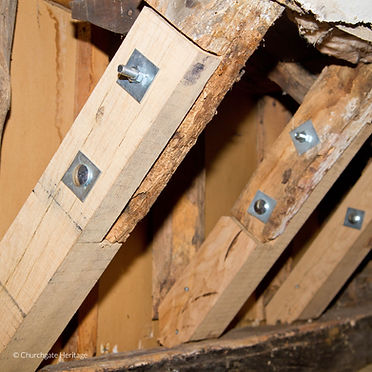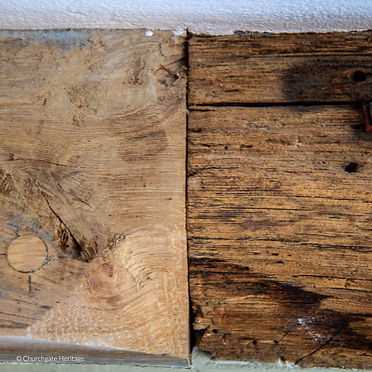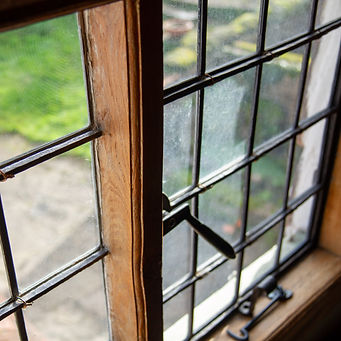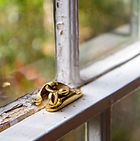
TIMBER
Over time, the timber in your home can deteriorate if not properly maintained or if issues are left unresolved. Persistent damp is one of the most significant threats to timber, and much of our repair work addresses its effects, whether historic or ongoing.
Our approach prioritises preserving the character and integrity of your home. We aim to retain as much of the original timber as possible, carefully replacing sections only when absolutely necessary.
Explore the services below to see how we can help restore and protect the timber in your home.
There are excellent publicly available resources on timber and its use in traditional buildings, as well as a range of other topics related to the conservation of historic buildings in the UK. If you're interested in learning more, please have a look at our Blog.
Rotten timber repair
Timber is particularly vulnerable to rot in damp or humid conditions, as these provide the ideal environment for fungi to thrive. If the underlying cause of rot—such as a leaking roof or excessive condensation—is still active, it’s essential to address this issue alongside any timber repairs. We can help assess whether additional remedial action is needed to prevent further damage.
Structural timber repairs may involve patching smaller areas, replacing entire sections, or incorporating steel reinforcement for added strength. When replacing timber components that require the dismantling of joints, we ensure they are reassembled using traditional methods to maintain authenticity and structural integrity.
Strengthening is achieved using a combination of timber joints, bolts, screws, and adhesives, selected based on the load and structural requirements. We employ a range of timber joint techniques tailored to the specific needs of the repair, ensuring durability and precision.
As part of a comprehensive repair, damage to infill panels—such as wattle and daub or brick—may also require attention. These repairs are carried out with care to complement the surrounding structure and maintain the character of your home.
See also Wattle & Daub, Brick & Stone and our Blog.

Timber joinery repairs

Non-structural timber elements in your home, such as doors, windows (see below), floors, and other joinery features, often require attention to maintain their functionality and appearance. Repairs may involve fixing loose joints, restoring or replacing damaged or missing parts, and ensuring the joinery operates smoothly and reliably.
Our approach focuses on preserving as much of the original timber as possible. Repairs can include patching new timber into damaged areas, reinforcing existing joinery with timber or steel components, or, when necessary, replacing entire sections while maintaining the character and integrity of your home.
For further advice and insights, visit our Blog, where you'll find detailed guidance notes on common timber elements and practical tips for their care and maintenance.
Structural timber repairs
Structural timber beams are integral to the stability and character of many historic and traditional buildings. Over time, these beams may require reinforcement, repair, or in some cases, replacement due to age, decay, or damage. When assessing the best course of action, we prioritise preserving as much of the original, historical timber as possible, ensuring that the building’s character and heritage are maintained.
Our repair methods are tailored to the specific needs of each beam:
-
Timber-to-Timber Repairs: Damaged sections of timber can be repaired by patching or replacing entire sections with carefully matched new timber.
-
Steel Reinforcement: For additional strength, beams may benefit from steel elements that work in harmony with the original structure to provide discreet yet effective support.
-
Traditional Joint Reassembly: If replacing a timber component involves dismantling an original joint, we reassemble it using the same traditional techniques to ensure authenticity.
We use a combination of timber joints, bolts, screws, and adhesives to strengthen and stabilise beams. The choice of joint depends on the size, location, and load-bearing requirements of the beam. Techniques such as scarf joints, half-lap joints, or mortise and tenon joints may be employed, depending on the specific demands of the repair.
In addition to structural stability, our work respects the aesthetic and historical integrity of your building, ensuring repairs blend seamlessly with the existing framework.
For further advice and insights, visit our Blog, where you'll find detailed guidance notes on common timber elements and practical tips for their care and maintenance.

Window repairs


Timber-framed windows are a defining feature of many historic homes, and repairing them is often a practical and cost-effective alternative to replacement. By opting for repairs, you can preserve the historical character of your property while extending the life of your windows.
Our repair services include:
-
Reinforcing weakened joints to restore structural integrity.
-
Repairing timber losses and damage caused by rot using timber-to-timber replacements or specialist consolidators and fillers.
-
Replacing worn or damaged sash cords to ensure smooth operation of sash windows.
-
Repairing lead cames and replacing broken lights.
-
Restoring cast iron frames.
For traditional windows that are draughty or thermally inefficient—a common challenge for listed property owners—we offer solutions that improve energy efficiency without compromising the original design. These options allow you to retain your windows' authentic charm while enhancing comfort and performance.
For more tips on maintaining warmth in your home, read our Blog post on Keeping Warm.

